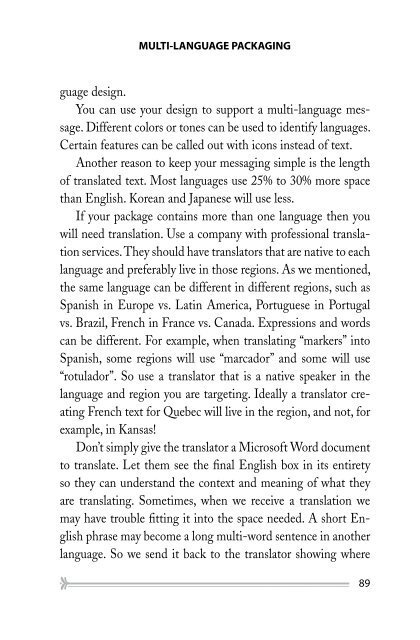The Art of Package Design
There is more to designing a successful package than just making it noticeable. This book explores how to get the most out of the design process and the regulations and legalities required in packaging. It also explores the pitfalls people fall into when trying to create packaging in multi-languages for sale in other markets and cultures. Written by Mark Lehberg, a 30+ year creative professional, this book offers creative insights and tips to create that perfect package.
There is more to designing a successful package than just making it noticeable. This book explores how to get the most out of the design process and the regulations and legalities required in packaging. It also explores the pitfalls people fall into when trying to create packaging in multi-languages for sale in other markets and cultures. Written by Mark Lehberg, a 30+ year creative professional, this book offers creative insights and tips to create that perfect package.
Create successful ePaper yourself
Turn your PDF publications into a flip-book with our unique Google optimized e-Paper software.
MULTI-LANGUAGE PACKAGING<br />
guage design.<br />
You can use your design to support a multi-language message.<br />
Different colors or tones can be used to identify languages.<br />
Certain features can be called out with icons instead <strong>of</strong> text.<br />
Another reason to keep your messaging simple is the length<br />
<strong>of</strong> translated text. Most languages use 25% to 30% more space<br />
than English. Korean and Japanese will use less.<br />
If your package contains more than one language then you<br />
will need translation. Use a company with pr<strong>of</strong>essional translation<br />
services. <strong>The</strong>y should have translators that are native to each<br />
language and preferably live in those regions. As we mentioned,<br />
the same language can be different in different regions, such as<br />
Spanish in Europe vs. Latin America, Portuguese in Portugal<br />
vs. Brazil, French in France vs. Canada. Expressions and words<br />
can be different. For example, when translating “markers” into<br />
Spanish, some regions will use “marcador” and some will use<br />
“rotulador”. So use a translator that is a native speaker in the<br />
language and region you are targeting. Ideally a translator creating<br />
French text for Quebec will live in the region, and not, for<br />
example, in Kansas!<br />
Don’t simply give the translator a Micros<strong>of</strong>t Word document<br />
to translate. Let them see the final English box in its entirety<br />
so they can understand the context and meaning <strong>of</strong> what they<br />
are translating. Sometimes, when we receive a translation we<br />
may have trouble fitting it into the space needed. A short English<br />
phrase may become a long multi-word sentence in another<br />
language. So we send it back to the translator showing where<br />
89



